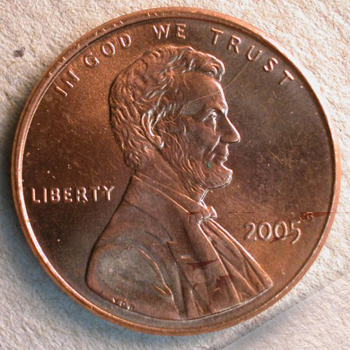Part VI. Striking Errors:
Weak Strikes:
Rim-restricted Second Strikes
Description: A second strike in which minimum die clearance has increased to such an extent that the dies only touch down on the design rim. Second strikes of this nature must also be off-center strikes.
Rim-restricted second strikes can be confused with similar-looking but unrelated striking errors. If it’s only slightly off-center, a rim-restricted second strike will look very much like a case of rim-restricted design duplication. The latter is a form of machine doubling in which the hammer die (it’s nearly always the hammer die) bounces off the surface of the coin, shifts to one side, and lands lightly on the design rim. If the second strike is significantly off-center, then a rim-restricted second strike can be confused with a double strike in which the first strike is off-center and minimally expanded while the second strike is centered.
This 2005 cent received a normal first strike and a slightly off-center rim-restricted second strike. Unlike a case of rim-restricted design duplication, die-struck design elements are present on both faces.
This 1992-P quarter received an abnormally strong first strike that caused finning of the design rim on the left side. The second strike is about 75% off-center, rotated 90 degrees clockwise, and die-struck on both faces. Second-strike design elements are almost completely restricted to the design rim. On the reverse face, the only recognizable second-strike feature is the design rim. No interior design elements are present on the reverse because much of the resistance to the impact of the hammer die was provided by a slightly elevated collar. This simultaneously softened the impact of the anvil die so that no details managed to strike up. DR2 = 2nd Strike Design Rim









